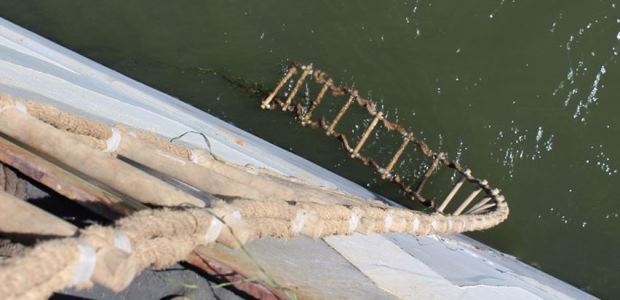
Wrong Equipment Cited in Drowning Investigation
The Transportation Safety Board of Canada's investigation found that the third officer used a rope ladder to read the seaward draft marks in the middle of the vessel. When resting flat against the vessel's hull, this ladder leaves little room for hand and foot holds, making it unsuitable for this task, and the rope ladder was rigged to the guardrail in such a way that there was no safe way to access the ladder from the deck.
The Transportation Safety Board of Canada released its investigation report Nov. 2 into a drowning that occurred in Quebec last year. The board found that unsuitable equipment and inadequate work procedures on the general cargo vessel Amazoneborg led to a crew member falling overboard and subsequently losing his life.
The cargo vessel was docked on Sept. 29, 2017, in the Port of Trois-Rivières, Quebec. The third officer was assigned to take the vessel's draft measurements as part of routine cargo operations. Some time after going to read the draft marks amidships on the seaward side, the third officer was reported missing. Search and rescue authorities conducted a search of the area without success. The third officer's body was found eight days later near Champlain, Quebec.
According to the board, the investigation found that the third officer used a rope ladder to read the seaward draft marks in the middle of the vessel. When resting flat against the vessel's hull, this ladder leaves little room for hand and foot holds, making it unsuitable for this task, and the rope ladder was rigged to the guardrail in such a way that there was no safe way to access the ladder from the deck. The third officer may have fallen while climbing over the vessel's guardrail to use the ladder or while using the ladder.
"While a permit was required to work overboard on the vessel, there were no instructions or procedures for taking draft measurements in the company or vessel manuals. The investigation found that no one was aware of the third officer's actions, no fall protection system or personal flotation device was used, and no one was present to initiate emergency response when the third officer went overboard," the board reported. "If routine tasks are not addressed in the shipboard operating procedures, there is a risk that these tasks will not be conducted safely and that unsafe practices will persist, endangering the lives of crewmembers."
After the death, the vessel's operator discontinued the use of rope ladders and replaced them with embarkation ladders. Use of a fall protection system and a personal flotation device and the presence of second crew member with access to lifebuoys and a communication system are now required for working overboard. The company also explained the various methods available for taking draft measurements to its crews.